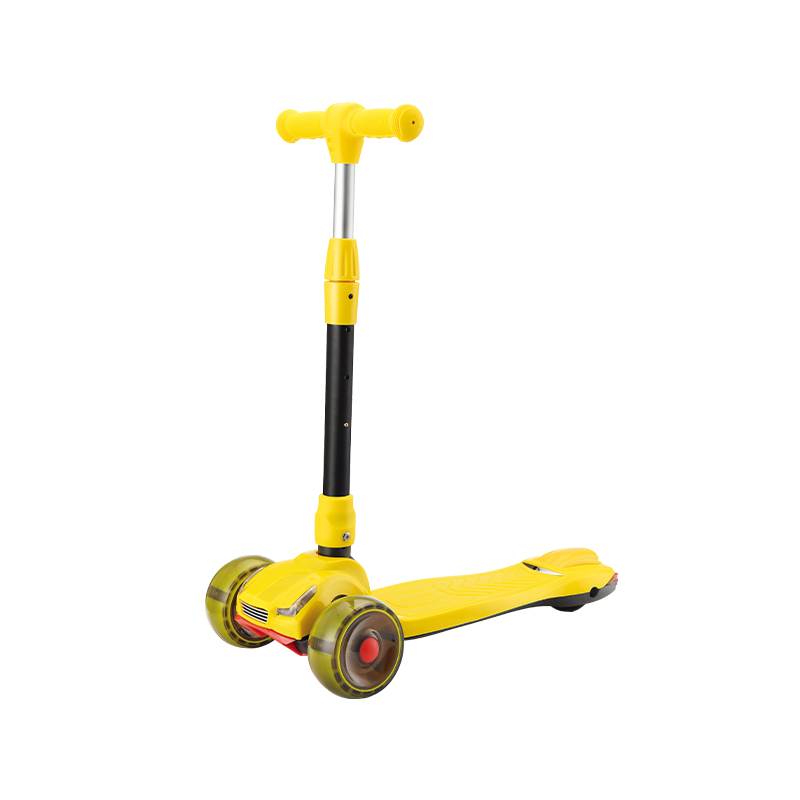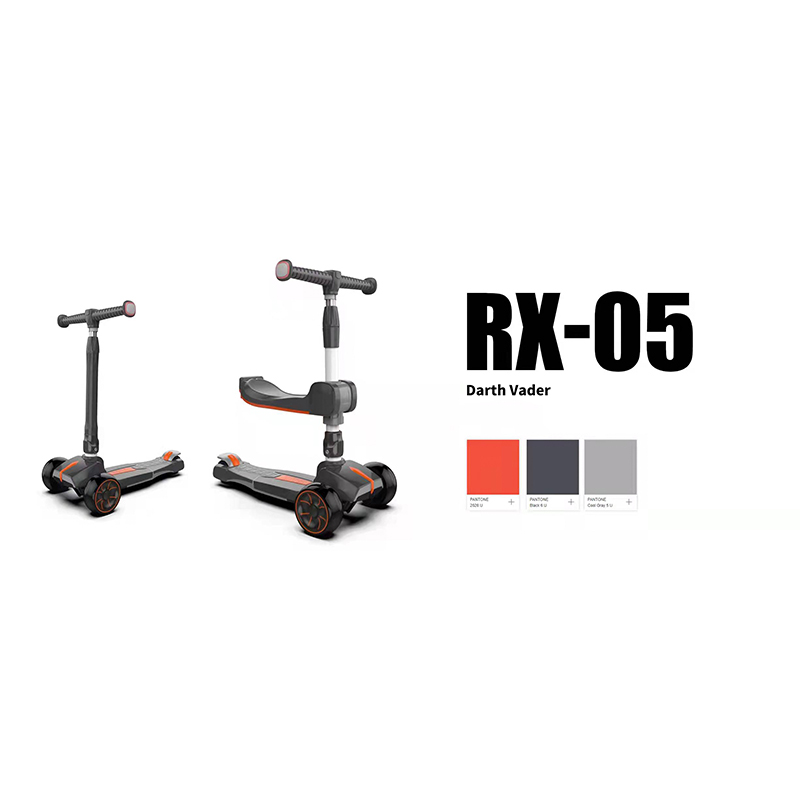How do children's kick scooters prevent foot entrapment and wheel entanglement, creating safety hazards?
Release Time : 2025-09-11
Safety is always a primary concern for parents when using children's kick scooters. Children are curious and energetic when playing, and their motor coordination is still developing. Accidents can easily occur due to sudden stops, turns, or loose clothing. Foot entrapment and clothing entanglement are among the most common safety hazards. Modern children's kick scooters utilize a series of sophisticated structural designs to mitigate these risks at the source, providing children with a free and safe environment for exercise.
The key to preventing foot entrapment lies in the space between the pedals and the rear wheel. Many traditional or low-quality kick scooters have a large gap between the end of the pedals and the rear wheel. If a child moves their feet backward while scooting, their toes can easily get caught in the gap between the wheel hub and the body. When the wheels spin at high speed, this can cause abrasions or even more serious injuries. To this end, high-quality kick scooters for children feature fully enclosed wheel guards, completely enclosing the top and sides of the rear wheels, leaving only the necessary turning space. This protective structure effectively blocks the possibility of foot contact with the wheels, preventing children from getting entangled or pinched even if they accidentally place their feet close to the wheel. Some models also feature raised running boards or anti-slip edges to further limit foot movement and enhance active protection.
The front wheel area also presents risks, particularly during steering, where improper foot placement can result in the fork or steering column being pinched. To address this, kick scooters typically feature wide running boards, clearly demarcating a safe area for standing feet. Curved guards around the front wheels provide greater clearance during cornering, preventing ankles or shoes from rubbing against the vehicle. Steering angle limiters are also widely used, limiting the maximum deflection of the front wheels to prevent oversteering, which could cause the vehicle to tip over, or place pressure on the feet. These are particularly useful for young children learning to ride.
The problem of clothing becoming entangled is primarily around the rear wheels. Loose pants, skirts, or shoelaces can dangle while scooting. If they come into contact with the high-speed wheels, they can easily become entangled and pulled, potentially damaging clothing or even causing children to lose their balance and fall. To address this risk, the Kick Scooter features a comprehensive anti-entrapment fender on the outside of the rear wheel. This not only protects against rain but also, more importantly, creates a physical barrier to prevent soft objects like fabric and ropes from entering the wheel axle area. The fender maintains a reasonable distance from the wheel to ensure proper rotation while covering all possible entrapment paths.
In addition, the overall scooter layout has been ergonomically optimized. The optimally lengthed footboards encourage children to place their feet parallel in the designated area, avoiding front-to-back misalignment. The adjustable handlebars allow children to hold the scooter in a natural, upright position, minimizing the risk of bending or tiptoeing. The low center of gravity enhances driving stability, reduces the chance of rollover, and indirectly mitigates the risk of physical collisions caused by imbalance.
The choice of materials also plays a role in safety design. Wheel arches and fenders are primarily made of tough, non-sharp-edged engineering plastic, ensuring they remain scratch-free even in the event of minor collisions. All exposed joints, screws, and moving parts have rounded corners to eliminate sharp protrusions, ensuring children are protected from scratches when getting in and out of the vehicle or when in close contact.
Some high-end models also incorporate intelligent safety features, such as night-time reflective strips and LED lighting, to enhance visibility in low-light conditions and prevent collisions caused by poor visibility. The overall structure is sturdy and durable, capable of withstanding the bumps and impacts of daily use, and preventing secondary injuries caused by loose or broken parts.
Attention to detail, every protective design reflects a deep understanding of children's behavior. Designers simulate children's postures, observe their movements, anticipate potential hazards, and optimize the structure one by one. This is more than just the manufacturing process of a toy car; it is a systematic effort to safeguard children's safety.
In summary, the Kick Scooter for Kids features a comprehensive safety system, including fully enclosed wheel covers, anti-entrapment guards, steering stops, pedal protection, and an ergonomic layout. It not only allows children to "ride" safely, but also allows them to "ride with peace of mind." These invisible yet crucial features allow parents to let go without worry, allowing their children to fully enjoy the joy of speed and freedom as they explore the world.
The key to preventing foot entrapment lies in the space between the pedals and the rear wheel. Many traditional or low-quality kick scooters have a large gap between the end of the pedals and the rear wheel. If a child moves their feet backward while scooting, their toes can easily get caught in the gap between the wheel hub and the body. When the wheels spin at high speed, this can cause abrasions or even more serious injuries. To this end, high-quality kick scooters for children feature fully enclosed wheel guards, completely enclosing the top and sides of the rear wheels, leaving only the necessary turning space. This protective structure effectively blocks the possibility of foot contact with the wheels, preventing children from getting entangled or pinched even if they accidentally place their feet close to the wheel. Some models also feature raised running boards or anti-slip edges to further limit foot movement and enhance active protection.
The front wheel area also presents risks, particularly during steering, where improper foot placement can result in the fork or steering column being pinched. To address this, kick scooters typically feature wide running boards, clearly demarcating a safe area for standing feet. Curved guards around the front wheels provide greater clearance during cornering, preventing ankles or shoes from rubbing against the vehicle. Steering angle limiters are also widely used, limiting the maximum deflection of the front wheels to prevent oversteering, which could cause the vehicle to tip over, or place pressure on the feet. These are particularly useful for young children learning to ride.
The problem of clothing becoming entangled is primarily around the rear wheels. Loose pants, skirts, or shoelaces can dangle while scooting. If they come into contact with the high-speed wheels, they can easily become entangled and pulled, potentially damaging clothing or even causing children to lose their balance and fall. To address this risk, the Kick Scooter features a comprehensive anti-entrapment fender on the outside of the rear wheel. This not only protects against rain but also, more importantly, creates a physical barrier to prevent soft objects like fabric and ropes from entering the wheel axle area. The fender maintains a reasonable distance from the wheel to ensure proper rotation while covering all possible entrapment paths.
In addition, the overall scooter layout has been ergonomically optimized. The optimally lengthed footboards encourage children to place their feet parallel in the designated area, avoiding front-to-back misalignment. The adjustable handlebars allow children to hold the scooter in a natural, upright position, minimizing the risk of bending or tiptoeing. The low center of gravity enhances driving stability, reduces the chance of rollover, and indirectly mitigates the risk of physical collisions caused by imbalance.
The choice of materials also plays a role in safety design. Wheel arches and fenders are primarily made of tough, non-sharp-edged engineering plastic, ensuring they remain scratch-free even in the event of minor collisions. All exposed joints, screws, and moving parts have rounded corners to eliminate sharp protrusions, ensuring children are protected from scratches when getting in and out of the vehicle or when in close contact.
Some high-end models also incorporate intelligent safety features, such as night-time reflective strips and LED lighting, to enhance visibility in low-light conditions and prevent collisions caused by poor visibility. The overall structure is sturdy and durable, capable of withstanding the bumps and impacts of daily use, and preventing secondary injuries caused by loose or broken parts.
Attention to detail, every protective design reflects a deep understanding of children's behavior. Designers simulate children's postures, observe their movements, anticipate potential hazards, and optimize the structure one by one. This is more than just the manufacturing process of a toy car; it is a systematic effort to safeguard children's safety.
In summary, the Kick Scooter for Kids features a comprehensive safety system, including fully enclosed wheel covers, anti-entrapment guards, steering stops, pedal protection, and an ergonomic layout. It not only allows children to "ride" safely, but also allows them to "ride with peace of mind." These invisible yet crucial features allow parents to let go without worry, allowing their children to fully enjoy the joy of speed and freedom as they explore the world.







